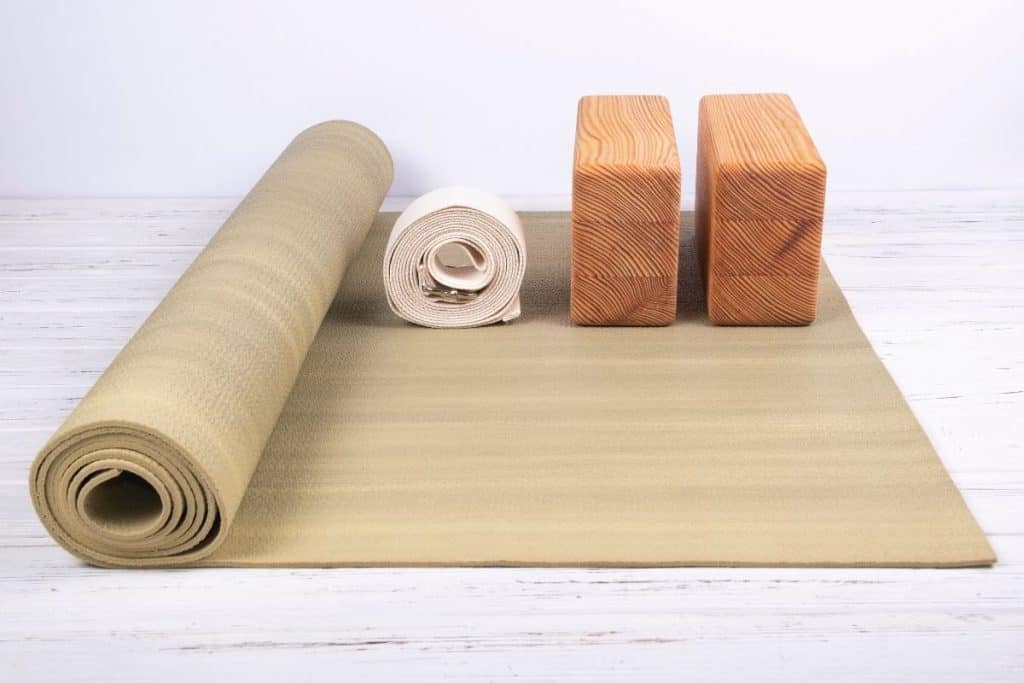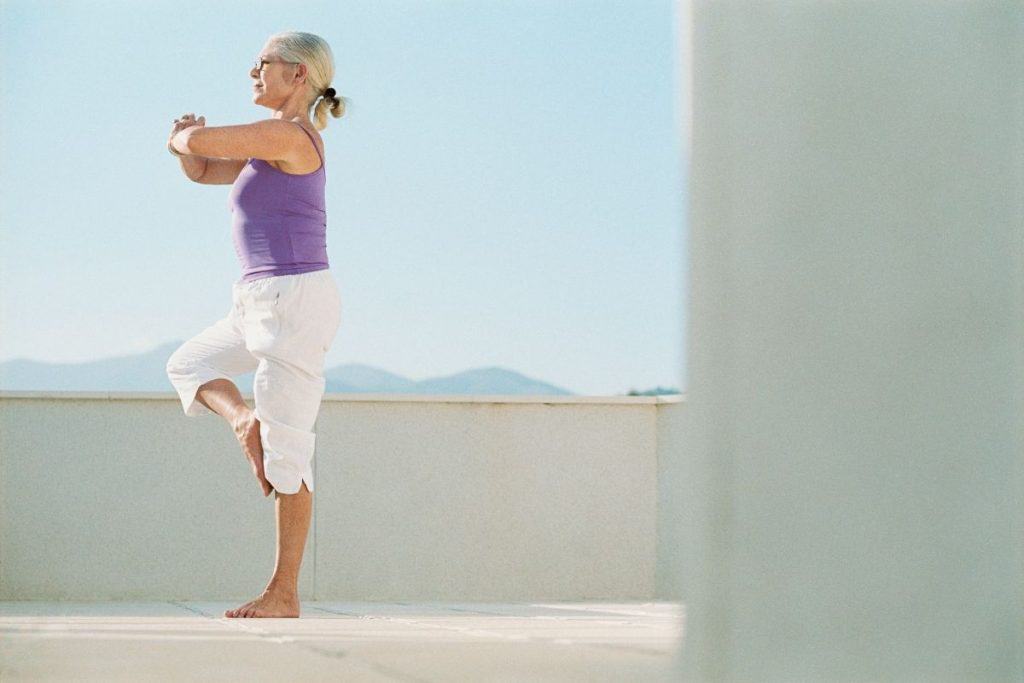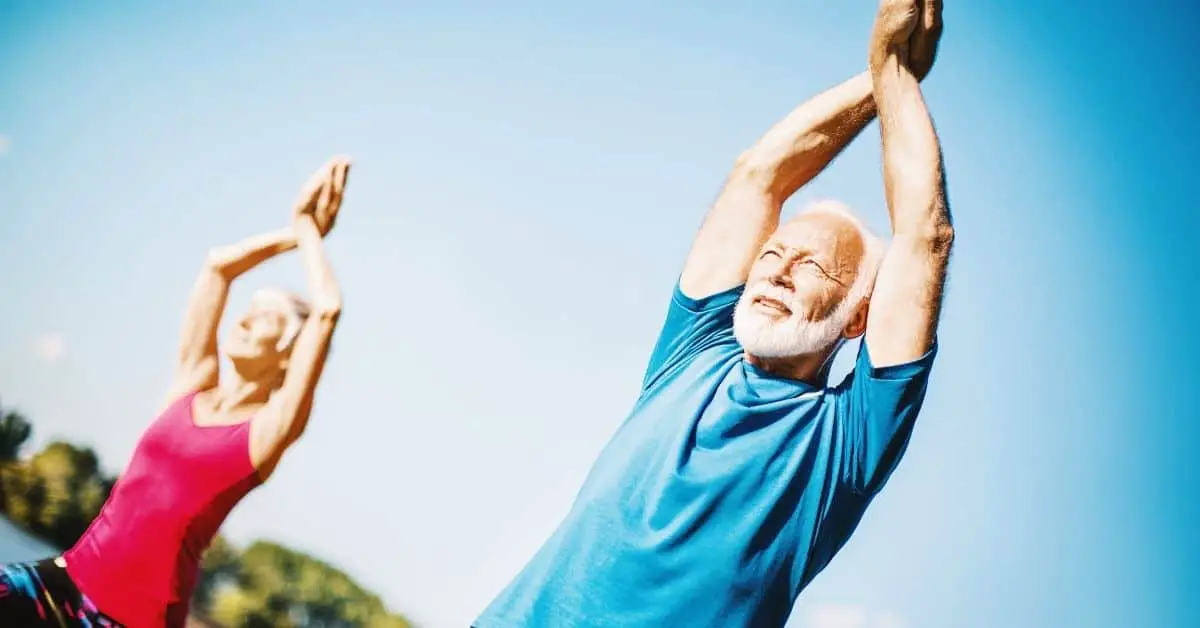Yoga is an effective way for seniors to improve themselves, both mentally and physically. If you are a senior, you’re maybe wondering how to get started in yoga.
To get started in yoga, you should talk to your doctor, pick a class, and use props. Yoga has tons of benefits for seniors, including reduced stiffness, stronger bones, healthier hearts, and more. Some of the best poses for seniors are child’s pose, cat-cow, and tree pose, among others.
This article will teach you how to start practicing yoga. We’ll then go over some of the most significant benefits of yoga and some beneficial poses for seniors.
How to Get Started in Yoga
If you are a senior who is new to yoga, don’t worry, this article has you covered. Listed below are four steps you should take to get started on your yoga journey.
Talk to Your Doctor
Before you start practicing yoga, visit your doctor. Your doctor will perform a physical examination and go over your medical conditions to determine if yoga will benefit you.

People with specific injuries or conditions may still be able to do yoga. However, additional precautions will likely need to be put in place. Make sure to discuss with your doctor what movements and positions are and are not safe for you to perform during class.
Pick a Class
If you are a senior who is new to yoga, you’ll want to pick a suitable class for your abilities and interests. Listed below are three popular types of courses that provide older yogis with yoga’s benefits in a gentle and manageable way.
Beginner’s Yoga
Check to see if there are beginner classes for seniors in your area. If not, search for a general beginners class. Beginner courses will provide you with the structure you need to learn how to do yoga safely.
However, all the beginner classes aren’t the same. Some courses will have more experienced instructors than others. You’ll want to make sure you find an instructor who is knowledgeable about your medical conditions and knows modified poses that are safe for you to perform.
If the instructor doesn’t know (or isn’t willing) to find substitute poses or give you props to help you out, then you may want to attend a different beginners class.
Chair Yoga
Chair yoga is an excellent way for you to receive yoga’s benefits without pushing yourself outside your limits. During chair yoga, you’ll perform various poses while seated or leaning against a chair.
Chair yoga makes poses more accessible for people suffering from certain conditions, including limited mobility. This form of yoga is also a great option if you have a hard time balancing since you’ll have the chair for support.
To check out chair yoga for yourself, watch this 17-minute class by Yoga with Adriene. Adriene goes over various poses you can perform while in a seated position or while using the chair for support:
Aqua Yoga
If you want an incredibly low impact way to do yoga, try aqua yoga. Aqua yoga is just like regular yoga, but it takes place in the water. This new form of yoga helps people with joint issues who struggle to do yoga on land. Water-based yoga reduces the stress on your body, providing you with all of the benefits you’d receive from a regular yoga class without any pain or discomfort.
To get a better idea of what an aqua yoga class looks like, take a peek at this video by Fitmotivation. This clip demonstrates a gentle aqua yoga class that was designed to help people with arthritis achieve a greater range of motion in their joints and a higher quality of life:
Use Props During Your Practice
Yoga props are excellent tools that help you learn new poses. They can help yogis do challenging poses that would be hard to execute without additional help. If you find any poses challenging, your yoga instructor may give you a prop to help you perform the pose.

Standard yoga props include blankets, blocks, yoga straps, and yoga bolsters. During chair yoga, you’ll use your chair as a prop. Similarly, in pool yoga, noodles are often incorporated into the session.
Stop (or Modify) if Something Hurts
Never force your body into poses that don’t feel good. If something hurts, stop. Ask your instructor for modified poses that will stretch the same (or similar) muscles without causing you pain. If you’d rather avoid doing a particular type of pose altogether, go into child’s pose, savasana, or another comfortable position while the rest of the class completes the pose.
Benefits of Yoga
Yoga provides fantastic benefits for everyone, including seniors.
Reduces Arthritis and Stiffness
As you age, you may develop stiffness or pain in your body. This may arise from certain conditions, such as arthritis, or it may merely be a symptom of aging. If you ever suffer from aches and pains, yoga may be an excellent activity for you to try.
One study found that yoga was able to reduce pain and stiffness among seniors with arthritis. Similarly, another study conducted in 2005 found that osteoarthritis participants experienced less pain and increased physical function if they regularly practiced yoga.
Strengthens Your Bones
Doing yoga helps to keep your bones healthy. Additionally, yoga may be able to reverse some of the bone-density lost due to osteoporosis.

In one study, researchers recruited 227 participants who practiced yoga for 12 minutes on a regular or semi-regular basis. By the end of the study, the participant’s spine and femur’s bone mineral density had improved. These results suggest that yoga can build up your bones, making them healthier and more robust than before.
Helps Keep Your Heart Healthy
Doing yoga may affect your blood pressure, which is a significant contributor to heart disease. One study found that participants over 40 who practiced yoga for approximately five years had lower blood pressure than those who did not.
Additionally, yoga may be able to influence heart disease. One study found that yoga, combined with a healthy diet and stress management classes, reduced “bad” cholesterol levels in participants and stopped the disease’s progression in 47% of the participants. While the effects of yoga by itself are still unclear, it could potentially help your heart get healthier.
Yoga is also a great way to minimize stress. Stress is a contributing factor to heart disease, so reducing it is another way to decrease your risk.
Enhances Your Quality of Life
If you want to be an all-around healthier, happier person, yoga may be the key.
Various studies have looked into yoga’s impact on people’s lives. In one study of 135 seniors, researchers discovered that six months of yoga improved their quality of life, mood, and lessened their fatigue more than walking or being in a control group. Another study of cancer patients found that yoga helped reduce their symptoms and improved overall wellbeing.
Yoga has also been found to give you a better night’s rest, improve social abilities, and reduce anxiety and depression.
Improves Balance
The principal cause of injury among seniors is falling. Having a good balance has been proven to reduce your chance of tumbling down. So, doing yoga may be a great way to improve your balance to prevent future injuries.

One study of participants who were 60+ discovered that practicing yoga resulted in improvements in balance and physical mobility. While further research still needs to be conducted, yoga may be a promising way to enhance your balance.
Helps Manage Type 2 Diabetes
If you struggle with Type 2 Diabetes, yoga may be an effective way to manage some of your symptoms or comorbid conditions.
Researchers discovered that yoga practices such as pranayama, asanas, mudras, pranayama, bandha, meditation, cleansing processes, mindfulness, and relaxation improved glucose tolerance and increased insulin sensitivity in patients with diabetes. So, regularly doing yoga may make your diabetes.
Aids People With Asthma and COPD
During yoga, there is a large emphasis on breathing, otherwise known as pranayama. During yoga, you focus on controlling your breath and expanding your lungs. You’ll also perform various breathing exercises to learn how to breathe through each pose.
In an article for Mater Hospital, Pulmonologist Keith Harris discusses how the breathing techniques learned in yoga can help people with asthma or COPD learn how to breathe through their breathlessness and improve their respiratory strength.
A study conducted on this topic backs Harris’s claims. Researchers discovered that individuals with COPD who performed yoga had a more significant amount of oxygen transfer from their lungs into their bloodstream than those who did not do yoga.
Has the Potential to Reduce Inflammation
Yoga may also help improve inflammation.
Inflammation isn’t always a bad thing. It’s a very natural (and helpful) bodily response. However, chronic inflammation is harmful and can lead to inflammation-related diseases, such as diabetes, heart disease, and cancer.
Two research studies have shown that yoga has an impact on inflammation. In the first study, researchers studied breast cancer survivors and found that yoga reduced their inflammation in as little as 12 weeks.
In the second study, 218 participants were put into either yoga or no yoga group. Then, they performed moderate to severe forms of exercise to induce stress on their bodies. The researchers found that individuals who did yoga have less inflammation at the end of the study than those who did not.
While the jury is still out about whether or not yoga has a significant effect on chronic inflammation, the preliminary results are promising.
May Improve Your Sleep
Are you frequently tired? Perhaps you have trouble falling asleep? Well, yoga may be just what you need to get a good night’s rest.
Yoga has been found to help elderly patients get a better night’s sleep. In one study, researchers compared yoga to a group that took herbal supplements and a control group. They found that the yoga group fell asleep faster, slept longer, and felt better rested than the other groups.
Keeping up with a regular yoga routine may also help patients with lymphoma catch some extra z’s. In one study, researchers discovered that patients who did yoga had fewer sleep disturbances, needed fewer sleep medications, and had enhanced sleep quality over those who did not do yoga.
So, why does yoga do this? While the exact mechanisms are still unknown, it’s recently been discovered that yoga helps the body release more melatonin, an important hormone that regulates your sleepiness and awakeness.
Take a look at this article if you want to read more about the best Yoga poses for a good nights sleep.
Best Poses for Seniors
Listed below are some of the most beneficial poses for seniors to perform during their yoga class.
Tree Pose
The tree pose is terrific for stretching your torso, groin area, thighs, and shoulders. It’s also a good pose for strengthening your calves, ankles, and abs. However, this pose’s most important function is its ability to improve your balance and overall coordination.

To perform this pose:
- Stand up and place your right foot against your left leg’s shin or thigh. Use your hand to help you place your foot on your leg. Avoid putting your foot directly on your knee, as this can lead to injury.
- Align your body. You may need to adjust your right and left hip so that they are aligned. Try not to pop either of your hips out to the side.
- Reach your arms up above your head. Your palms should be facing inwards towards each other. If you have enough flexibility in your shoulders, put your hands in a prayer position above your head.
- Balance for 20-30 seconds. Look at something in front of you that isn’t moving. This will help you keep your balance.
- Repeat with your other leg. If you are struggling to maintain your balance, hold onto something. If that is still too challenging, there are ways to perform this pose while sitting in a chair.
Cat-Cow
Cat-cow helps to improve your posture and balance. It’s also an excellent stretch for your back, hips, and abdomen.

If you’d like to make this pose more comfortable on your knees, add additional padding, such as a blanket, beneath them. Sometimes your wrists feel uncomfortable during this pose. You can try to form fists with your hands to alleviate some of the pressure.
If you’d prefer, this pose can also be done in a seated position, during which you’ll place your hands on your knees. If you have any neck problems, keep your head in line with your spine throughout this pose. Continue to move through these two motions with your breath.
Follow these steps to perform cat-cow:
- Start in a table-top position. You should be on your hands and knees with a neutral spine.
- Move into cow pose. Take a deep inhale, then allow your stomach to sink towards the ground. Your rear and head should be pressing upwards.
- Let out a deep exhale. As you exhale, move into cat pose.
- Move into cat pose. Arch your spine and tuck your tailbone down. Then, let your head fall downwards towards your chest.
Child’s Pose
This pose is a wonderful way to stretch out your thighs, hips, back, hips, and ankles. It is also very calming, so it’s a great way to unwind and release tension after a long day.

To get into child’s pose, follow these steps:
- Begin on your hands and knees in a table-top position.
- Spread your knees wide. Next, you’ll spread your knees out wide but keep your toes together.
- Bring your stomach and forehead to the ground. Your arms can either lay on the floor beside you or in front of you for an added stretch.
Downward Facing Dog
This famous pose is excellent for your body. It helps stretch your hamstrings, calves, hands, and shoulders while simultaneously strengthening your legs and arms. If you have osteoporosis, high blood pressure, sciatica, asthma, or flat feet, this pose may have some beneficial effects. Downward dog is also useful for relieving headaches, insomnia, back pain, and menstrual cramps.
If you have diarrhea, carpal tunnel syndrome, high blood pressure, or frequent headaches, you’ll want to consult with your doctor before trying to perform this pose.
To try downward dog for yourself, follow these steps:
- Start in a table-top position. Make sure your fingers are spread out, and your hands are shoulder-width apart. You want your knees to be slightly behind your hips.
- Press off of the mat. Tuck your toes, then raise your knees off of the ground. Make your legs as straight as you can.
- Create space between your shoulders. Try to relax your shoulders and bring them away from your ears. Doing this will help ease any tension you may be holding in your shoulders and neck.
- Inhale and exhale deeply throughout the pose. Always remember to breathe. Once you are done with the pose, gently put your knees back onto the floor and untuck your toes.
Check out this video for some additional guidance regarding how to get into this pose:
Extended Puppy
This pose is a blend between child’s pose and downward dog. This lengthening pose will stretch your spine without adding too much pressure on your knees and hips.
Do these steps to get into extended puppy pose:
- Begin in a table-top position. Align your wrists under your shoulders and knees or under your hips if you need a little extra cushioning. Then, place a towel under your knees.
- Walk your hands in front of you. You want your arms to be extended far enough so that your chest is close to the floor. Keep your hips off of the ground.
- Press your arms into the floor. Keep your head down.
- Stay in the pose for approximately 20 to 30 seconds. Once you’re done, go back to the table-top position.
Warrior II
Warrior II is a powerful pose. It helps strengthen your arms, back muscles, shoulders, and legs. This pose also targets your neck, chest, psoas, and stomach, giving you a nice stretch throughout your body.
If you suffer from flat feet, carpal tunnel syndrome, osteoporosis, and sciatica, this pose may be especially beneficial. If you are pregnant and are experiencing back pain, this pose can alleviate some of the tension.
If you have high blood pressure, talk to your doctor before performing this pose. If you have neck problems, don’t turn your head to look at your front hand. Instead, continue to look straight ahead. Additionally, this pose can be modified so you can do it on a chair. Ask your yoga instructor to demonstrate this modification.
To learn how to perform warrior II with perfect alignment, watch this video by Yoga International. This pose requires more steps than the others on our list, so watching a video will be the easiest way to learn it:
Mountain Pose
Mountain pose looks like you are just standing up. However, it is so much more than that. This invigorating pose strengthens your entire body when done correctly, including your abs, butt, thighs, ankles, and knees. This pose can also relieve some discomfort if you suffer from back pain, sciatica, or flat feet.
Since mountain pose involves balancing, you may not want to do this pose if you have low blood pressure or frequent headaches and insomnia. Talk to your doctor to determine if this pose is safe for you.
To do mountain pose, follow these steps:
- Begin standing with your feet close together. If it’s difficult for you to balance, you can move your feet farther apart. If it’s still too challenging, stand against a wall while executing this pose.
- Activate your muscles. Tighten your thighs and torso. Imagine energy going through your body from your toes to your head. You need to do this pose with intention and awareness to receive the fantastic benefits.
- Press your shoulder blades back. Allow your arms to hang by your sides.
Triangle Pose
Triangle pose is a fantastic pose that strengthens the legs, ankles, knees, obliques, abs, and back. It also stretches your muscles, specifically those in the calves, groin, hamstring, and shoulders. This useful pose helps relieve constipation and improves digestion. It’s also commonly used in therapeutic settings to aid with infertility, anxiety, sciatica, and neck issues.
To do triangle pose, perform the following steps:
- Move your legs apart. Start with your feet wide, approximately 3 1/2 feet to 4 feet (106.7 cm to 121.9 cm) apart.
- Move your arms into a “T” position. Relax your shoulders. Try not to scrunch them up towards your ears.
- Adjust your feet. Turn your right foot so that it’s at a 90 angle. Keep your left foot facing forward. If you are standing correctly, your right foot should be perpendicular to your left foot.
- Lengthen your torso and bend. Make sure your chest is in line with your hips as you fall forward.
- Put your right arm on the ground. If you can’t reach the ground, either put your hand on another part of your leg or a block.
- Put your left arm up into the air. Lengthen your arm up towards the sky and activate your core muscles.
If you need a little extra help getting into this pose, check out this helpful video by Andrea from Well & Good. This video will teach you the right (and wrong) way to do triangle pose so that you’ll know if you are doing it correctly in the future:
Supine Spinal Twist
Supine spinal twists give you a nice rotation in your back in a gentler way than some other twists you’ll find in yoga. This type of twist is terrific for stretching your chest and glutes. It is also helpful for achieving greater mobility in your spine and helping with digestion.
Be cautious doing this pose if you have any back issues, especially a herniated disc. Remember, you should always contact your doctor to determine if twisting moves are safe for you.
- Lie on your back and bend your knees. Put your feet flat on the floor.
- Move your hips slightly to the right. Lift your hips a little off of the ground and shift them to the right. Doing this will help you stack your hips on top of each other when you do the twist.
- Move your right knee into your chest. Keep your left leg extended in front with a flexed foot.
- Cross your right knee over your body. Your knee should rest on the floor on the left side of your body.
- Extend your arms in a T-shape. If you’d prefer, you can extend your right arm out and put your left hand on your right knee.
- Turn your head to the right side. You should be gazing outwards towards your fingertips.
- Hold the pose for approximately 30 seconds and repeat on the other side. To switch sides, drop both legs to the floor and adjust your hips to the left.
Conclusion
Yoga is very beneficial, especially for seniors. Research indicates doing yoga has numerous health benefits, including strengthening bones, improving arthritis, and more.
Talk to your doctor before you hit the mat. Then, find a class that is suited for you. Once you’re in class, don’t be afraid to use props, and always stop if a pose doesn’t feel right.
Some of the best poses for seniors are child’s pose, downward-facing dog, cat-cow, triangle pose, supine spinal twist, tree pose, mountain pose, warrior II and extended puppy. All of these poses provide tremendous benefits for the body.
Sources
- Great Senior Living: Yoga for Seniors: How to Get Started (And Why You Should)
- IJYT: Yoga for Seniors with Arthritis: A Pilot Study
- IJYT: The Use of Yoga for Physical and Mental Health Among Older Adults: A Review of the Literature
- Healthline: 13 Benefits of Yoga That Are Supported by Science
- Verywell Fit: Before You Start Yoga for Seniors
- CNY Healing Arts: The Health Benefits of Cat-Cow Stretch
- American Senior Communities: Yoga for Seniors
- Verywell Fit: How to Do Child’s Pose (Balasana) in Yoga
- Oxford Academic: Age and Aging: Yoga-based exercise improves balance and mobility in people aged 60 and over: a systematic review and meta-analysis
- Yoga Journal: Extended Triangle Pose
- Yoga Journal: Warrior II Pose
- Yoga Journal: Downward-Facing Dog
- Yoga Journal: Mountain Pose
- Active: Pose of the Month: Triangle
- Yoga Outlet: How to Do Mountain Pose in Yoga
- Yoga Outlet: How to Do Tree Pose in Yoga
- GI Society: Yoga
- Compass by WebMD: 6 Yoga Poses That Age Well
- NCBI: Twelve-Minute Daily Yoga Regimen Reverses Osteoporotic Bone Loss
- NCBI: Therapeutic Role of Yoga in Type 2 Diabetes
- Mercy Health: Yoga for Beginners: How to Triangle Pose
- Destination Yoga: How To Do Downward Dog
- Mather Hospital: Unexpected Benefits of Yoga for Asthma and COPD
- YouTube: How To Do Triangle Pose | The Right Way | Well+Good
- Wikihow: How to Use Yoga Props
- YouTube: Downward Dog – Downward Facing Dog Yoga Tutorial
- Verywell Fit: How to Do Tree Pose (Vrksasana) in Yoga
- YouTube: Aqua Yoga for Arthritis
- YouTube: How to Do Warrior II Pose with Correct Alignment
Sitasyoga.com is a participant in the Amazon Services LLC Associates Program, an affiliate advertising program designed to provide a means for sites to earn advertising fees by advertising and linking to Amazon.com. We also participate in other affiliate programs which compensate us for referring traffic.





